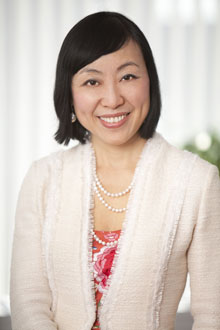Dr Lan Huang is co-founder, chairman and CEO of a New York-headquartered clinical-stage company within a regulatory framework that sees the firm conduct trials both in the US, where the company is based and listed, and in China.
‘We have a robust pipeline from internal development and from our research agreements with institutions such as the Fred Hutchinson Cancer Research Center and University of Washington,’ explains Dr Huang. BeyondSpring’s lead asset – a ‘direct anticancer agent in non-small cell lung cancer’ called Plinabulin – is currently in phase three clinical trials across both countries.
 Dr Lan Huang, BeyondSpring Pharmaceuticals |
Dr Huang, who has more than a decade of entrepreneurial experience in the Chinese and US biotechnology industry, explains that the firm’s unique business model ‘supports the development of multiple products in a time and cost-efficient manner’.
But this isn’t an even US-China split. In fact, the company conducts the vast majority of its clinical trials in China. ‘In our current non-small cell lung cancer trial, we are enrolling 80 percent of the patients in China, ad 20 percent of them in the US and other counties,’ explains Dr Huang. ‘Part of the reason for this is the number of lung cancer patients in China – some 700,000, says Dr Huang, compared with only 200,000 in the US. Chinese patients are also more likely to sign up for trials, she adds.
‘In China, a greater proportion of cancer patients enroll in clinical trials, and the trials are held in central locations, such as Beijing, Shanghai and the Guangzhou area so you can enroll patients very fast,’ she continues. ‘In the US, sometimes only 4 percent to 6 percent of patients enroll in clinical trials, and there are hundreds of trials competing at any given time, which slows the process significantly.’
Then there’s cost-efficiency. ‘In China, each patient costs between one third and one fifth of the US patient cost, so if we enroll 80 percent of our patients from China, it adds to our overall cost benefit,’ says Dr Huang, adding that BeyondSpring is able to operate in this way because the company has a local presence in Dalian. ‘We have people who help to oversee the trials according to US Good Clinical Practice (GCP) regulations.’
But it can be tricky explaining the set-up to potential investors: while they understand the clinical data that supports the company’s market opportunities, they do not ‘yet seem to completely grasp how BeyondSpring’s US-China integration model can drive a more time and cost-efficient drug development process,’ says Dr Huang.
So since BeyondSpring’s Nasdaq IPO (and concurrent private placement) in March this year, the $900 mn market cap company – along with IR consultants KCSA – has been focused on communicating to investors the firm’s regulatory strength in China. Its scalable US-China integration model can speed up the drug development process, says Dr Huang, ‘which allows us to apply for approval in the US and China in parallel’, while ‘access to the vast clinical resources in China can speed the path to commercialization.’
Then there’s the fact that China is the second-largest pharmaceutical market in the world, beaten only by the US.
Aside from this, though, Dr Huang says BeyondSpring faces the same issues as most other small caps: ‘Our challenges are fairly typical, compared with other clinical-stage biotech companies.’ And while the market environment for small-cap biotechs has been challenging over the past 18 months or so, Dr Huang says that having received funding to complete two new drug application submissions for Plinabulin through its IPO and private placement, the firm is not constrained in terms of finances.
Post-IPO, Dr Huang says the team has been ‘working to introduce BeyondSpring to the investor and analyst communities and build relationships. There have been several initiatives we have been focusing on as we grow more accustomed to being a public company.
‘First, we have been working to integrate the earnings reporting process into our workflow, including the issuance of earnings press releases, holding quarterly conference calls with members of the investment community, laying out a schedule to ensure we are consistently communicating with the Street and refining our corporate messages to best communicate BeyondSpring’s unique strengths.’
And what’s been the firm’s biggest IR challenge to date? Like many small caps, Dr Huang cites raising the company’s corporate profile. As the company puts its IR efforts into ‘identifying the appropriate analysts and investors active in our space’, the main questions it answers are of course focused around its key asset, Plinabulin: on timelines for data reporting and the results of its US and China trials.
‘We believe we are well positioned to communicate the BeyondSpring story,’ says Dr Huang. ‘We have clearly defined near-term catalysts in as little as six months, with multiple shots on goal with Plinabulin. But we are still a small enough organization to remain focused on executing our strategic plan.’










